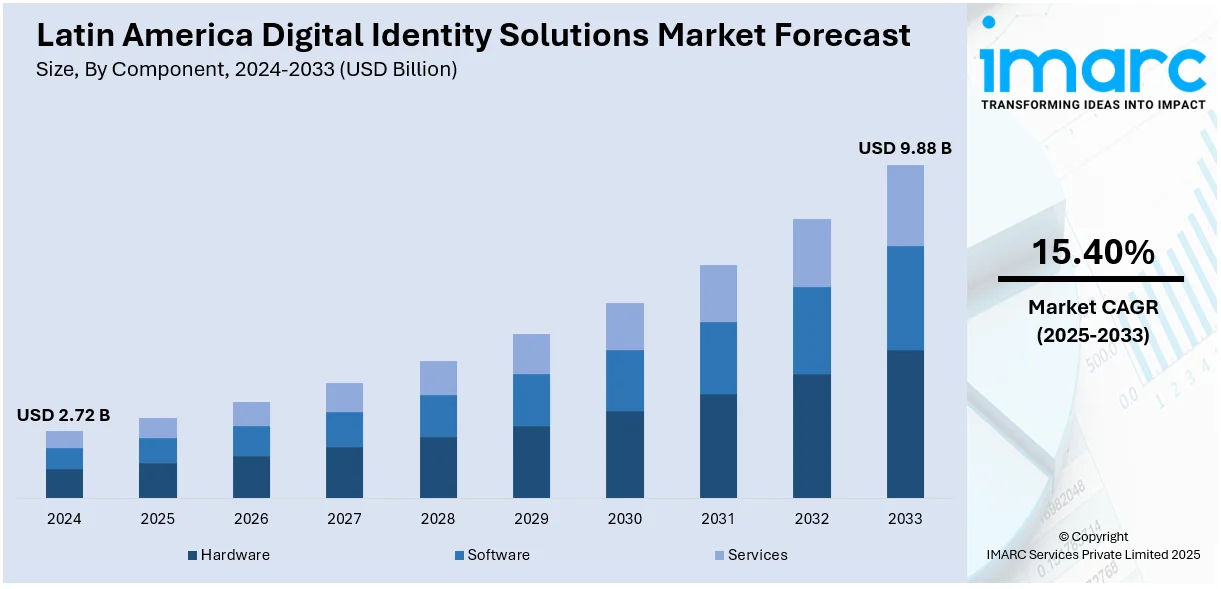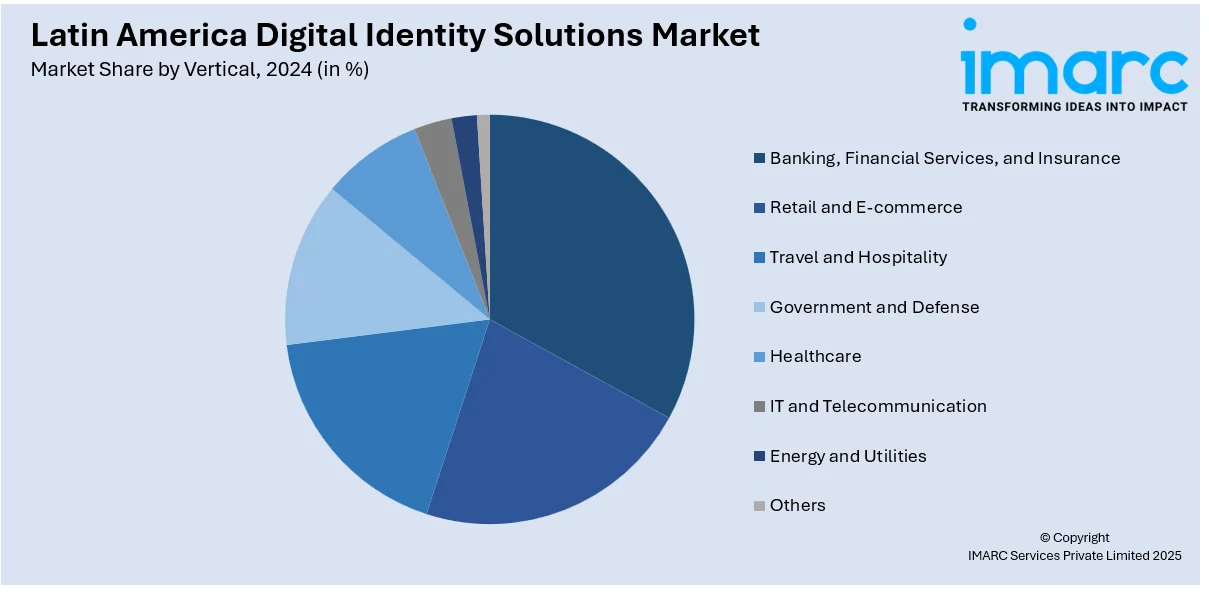
Latin America Digital Identity Solutions Market Size, Share, Trends and Forecast by Component, Identity Type, Solution Type, Organization Size, Deployment, Vertical, and Country, 2025-2033
Latin America Digital Identity Solutions Market Overview:
The Latin America digital identity solutions market size reached USD 2.72 Billion in 2024. Looking forward, IMARC Group expects the market to reach USD 9.88 Billion by 2033, exhibiting a growth rate (CAGR) of 15.40% during 2025-2033. The growing cybersecurity concerns, government efforts for digital transformation, increased demand for secure online transactions, and the need for identity verification in the banking, healthcare, and e-commerce sectors are some of the key factors influencing the market growth.
|
Report Attribute
|
Key Statistics
|
|---|---|
|
Base Year
|
2024 |
|
Forecast Years
|
2025-2033
|
|
Historical Years
|
2019-2024
|
| Market Size in 2024 | USD 2.72 Billion |
| Market Forecast in 2033 | USD 9.88 Billion |
| Market Growth Rate 2025-2033 | 15.40% |
Latin America Digital Identity Solutions Market Trends:
Increasing regulatory frameworks
The governments within Latin America actively understand the value of protected digital identities because they help build security while improving service delivery to citizens and advancing economic development. The introduction of comprehensive regulatory frameworks, such as Brazil’s General Data Protection Law (LGPD) and Mexico’s Digital Identity Strategy, is encouraging organizations to adopt digital identity solutions. According to the Latin America digital identity solutions market forecast, these regulations mandate stricter controls over personal data and the authentication processes, leading to a growing demand for solutions that comply with these standards. For instance, in September 2024, the Brazilian government recently issued Decree No. 12,069, which specifies the country's digital transformation objectives and emphasizes the importance of interoperability, data protection, and cybersecurity to support its DPI goals. It establishes a regulatory framework for the Gov.br platform and other digital public infrastructure efforts, ensuring that these systems follow worldwide best practices. Companies are required to implement robust identity management systems to ensure compliance, driving innovation and investment in digital identity technologies.

Rise of digital transformation across industries
Increasing digitalization across various sectors, including banking, healthcare, and government services, is a major trend propelling the Latin America digital identity solutions market share. Organizations are rapidly implementing digital solutions to increase operational efficiency, and customer experiences, and satisfy changing consumer expectations. Banks, for example, are putting in place digital identity verification systems to make remote account opening and internet transactions more safe. Healthcare businesses utilize digital identity systems to safeguard patient medical records and enhance telehealth service functionality. This trend is further supported by the shift towards remote services and increased reliance on digital interactions, boosting the need for reliable and secure digital identity solutions. For instance, in November 2024, World, a provider of biometric identity verification technology that authenticates human users through iris scanning and face recognition, announced the introduction of its ID verification services in Brazil, bringing the most recent version, World ID 3.0, to South America's largest country. The platform's fundamental technology combines physical biometric verification with digital identification credentials to assist enterprises in distinguishing between real users and artificial intelligence bots. This development followed the company's inaugural preview in Brazil in 2023, which included pop-up events.
Heightened demand for secure online transactions
With the burgeoning growth of the e-commerce industry across Latin America, there is an increasing demand for safe online transactions. With the increasing consumer awareness regarding cybersecurity concerns and the assurance of personal data protection has become a priority. Biometric authentication, multi-factor authentication, and identity verification services are critical for reducing fraud and guaranteeing safe transactions. Businesses are investing in sophisticated identification systems to increase consumer trust and secure critical data. Furthermore, the proliferation of mobile payment solutions and digital wallets highlights the importance of safe identity verification processes, resulting in an expanding demand for advanced identification technologies, which, in turn, is creating a positive Latin America digital identity solutions market outlook. For instance, in January 2024, Prove Identity, Inc., the global pioneer in digital identity, announced a strategic relationship in Brazil with TargetData, one of the country's leading big data analytic organizations. The deal will allow more significant companies in Brazil to use Prove's digital identity verification and authentication solutions.
Latin America Digital Identity Solutions Market Segmentation:
IMARC Group provides an analysis of the key trends in each segment of the market, along with forecasts at the regional level for 2025-2033. Our report has categorized the market based on component, identity type, solution type, organization size, deployment, and vertical.
Component Insights:
- Hardware
- Software
- Services
The report has provided a detailed breakup and analysis of the market based on the component. This includes hardware, software, and services.
Identity Type Insights:
- Biometric
- Fingerprint Recognition
- Facial Recognition
- Iris Recognition
- Voice Recognition
- Palm/Hand Recognition
- Others
- Non-biometric
A detailed breakup and analysis of the market based on the identity type have also been provided in the report. This includes biometric (fingerprint recognition, facial recognition, iris recognition, voice recognition, palm/hand recognition, and others) and non-biometric.
Solution Type Insights:
- Identity Verification
- Authentication
- Single-factor Authentication
- Multi-factor Authentication
- Identity Lifecycle Management
- Others
A detailed breakup and analysis of the market based on the solution type have also been provided in the report. This includes identity verification, authentication (single-factor authentication and multi-factor authentication), identity lifecycle management, and others.
Organization Size Insights:
- Large Enterprises
- Small and Medium Enterprises
A detailed breakup and analysis of the market based on the organization size have also been provided in the report. This includes large enterprises and small and medium enterprises.
Deployment Insights:
- On-premises
- Cloud
A detailed breakup and analysis of the market based on the deployment have also been provided in the report. This includes on-premises and cloud.
Vertical Insights:

- Banking, Financial Services, and Insurance
- Retail and E-commerce
- Travel and Hospitality
- Government and Defense
- Healthcare
- IT and Telecommunication
- Energy and Utilities
- Others
A detailed breakup and analysis of the market based on the vertical have also been provided in the report. This includes banking, financial services, and insurance, retail and e-commerce, travel and hospitality, government and defense, healthcare, IT and telecommunication, energy and utilities, and others.
Country Insights:
- Brazil
- Mexico
- Argentina
- Colombia
- Chile
- Peru
- Others
The report has also provided a comprehensive analysis of all the major regional markets, which include Brazil, Mexico, Argentina, Colombia, Chile, Peru, and others.
Competitive Landscape:
The market research report has also provided a comprehensive analysis of the competitive landscape. Competitive analysis such as market structure, key player positioning, top winning strategies, competitive dashboard, and company evaluation quadrant has been covered in the report. Also, detailed profiles of all major companies have been provided.
Latin America Digital Identity Solutions Market News:
- In October 2024, Buenos Aires launched QuarkID, a digital identification service that uses zero-knowledge proofs to improve privacy and streamline identity verification processes. The tool is embedded into the city's miBA app, allowing 3.6 million citizens to safely verify their documents without giving any additional personal data. QuarkID uses the Ethereum layer-2 network ZKsync Era and supports more than 60 document types. It attempts to lessen the risk of identity theft while also lowering government operational expenditures .
- In November 2023, The world leader in digital identification, Prove identification, Inc. ("Prove"), announced that Elo, a payment technology business that is entirely Brazilian, will adopt Prove's identity verification solutions to enhance consumer experiences while thwarting the growth of "orange accounts" and SIM swap fraud in Brazil.
- In July 2024, The Artificial Intelligence Readiness Assessment of Mexico, a joint effort by UNESCO and the National Alliance for Artificial Intelligence (ANIA), discovered that Mexico is well-positioned to become a regional leader in AI and recommends the implementation of a single digital identity system for the country.
Latin America Digital Identity Solutions Market Report Coverage:
| Report Features | Details |
|---|---|
| Base Year of the Analysis | 2024 |
| Historical Period | 2019-2024 |
| Forecast Period | 2025-2033 |
| Units | Billion USD |
| Scope of the Report |
Exploration of Historical Trends and Market Outlook, Industry Catalysts and Challenges, Segment-Wise Historical and Future Market Assessment:
|
| Components Covered | Hardware, Software, Services |
| Identity Types Covered |
|
| Solution Types Covered |
|
| Organization Sizes Covered | Large Enterprises, Small and Medium Enterprises |
| Deployments Covered | On-Premises, Cloud |
| Verticals Covered | Banking, Financial Services, And Insurance, Retail and E-Commerce, Travel and Hospitality, Government And Defense, Healthcare, IT And Telecommunication, Energy And Utilities, Others |
| Countries Covered | Brazil, Mexico, Argentina, Colombia, Chile, Peru, Others |
| Customization Scope | 10% Free Customization |
| Post-Sale Analyst Support | 10-12 Weeks |
| Delivery Format | PDF and Excel through Email (We can also provide the editable version of the report in PPT/Word format on special request) |
Key Questions Answered in This Report:
- How has the Latin America digital identity solutions market performed so far and how will it perform in the coming years?
- What is the breakup of the Latin America digital identity solutions market on the basis of component?
- What is the breakup of the Latin America digital identity solutions market on the basis of identity type?
- What is the breakup of the Latin America digital identity solutions market on the basis of solution type?
- What is the breakup of the Latin America digital identity solutions market on the basis of organization size?
- What is the breakup of the Latin America digital identity solutions market on the basis of deployment?
- What is the breakup of the Latin America digital identity solutions market on the basis of vertical?
- What is the breakup of the Latin America digital identity solutions market on the basis of region?
- What are the various stages in the value chain of the Latin America digital identity solutions market?
- What are the key driving factors and challenges in the Latin America digital identity solutions market?
- What is the structure of the Latin America digital identity solutions market and who are the key players?
- What is the degree of competition in the Latin America digital identity solutions market?
Key Benefits for Stakeholders:
- IMARC’s industry report offers a comprehensive quantitative analysis of various market segments, historical and current market trends, market forecasts, and dynamics of the Latin America digital identity solutions market from 2019-2033.
- The research report provides the latest information on the market drivers, challenges, and opportunities in the Latin America digital identity solutions market.
- Porter's five forces analysis assist stakeholders in assessing the impact of new entrants, competitive rivalry, supplier power, buyer power, and the threat of substitution. It helps stakeholders to analyze the level of competition within the Latin America digital identity solutions industry and its attractiveness.
- Competitive landscape allows stakeholders to understand their competitive environment and provides an insight into the current positions of key players in the market.
Need more help?
- Speak to our experienced analysts for insights on the current market scenarios.
- Include additional segments and countries to customize the report as per your requirement.
- Gain an unparalleled competitive advantage in your domain by understanding how to utilize the report and positively impacting your operations and revenue.
- For further assistance, please connect with our analysts.
 Inquire Before Buying
Inquire Before Buying
 Speak to an Analyst
Speak to an Analyst
 Request Brochure
Request Brochure
 Request Customization
Request Customization




.webp)




.webp)












